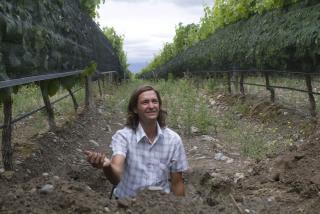Malbec Gold
POSTED ON 11/05/2010It was good of Wines of Argentina to bring the Argentina Wine Awards to London. The gold and trophy winners decided by an international panel of Masters of Wine in Mendoza in February were shown at a tasting hosted by Argentinian wine champion Phil Crozier at The Gaucho Grill in London’s Swallow Street, always an apt venue for a wine tasting. As far as I know, this was the first time a panel made up just of Masters of Wine was put together for the purpose of judging a set of international awards. That ruled me out then, but less explicably, it ruled out Marina Gayan, Argentina’s only Master of Wine and the woman who runs the Argentina panel at the Decanter World Wine Awards. I am baffled.
 Uco Valley
Uco Valley
Be that as it may, there were 44 wines to taste, but as I’d just spent the morning at the Decanter International trophies tasting and the afternoon at Majestic’s excellent summer tasting, I thought I’d better pace myself. Just as well really since by the time I got to some of the more up-market malbecs, I could hardly even lift the 1.2 kilo bottles (empty) let alone taste the wines. It really is about time someone took the Argentinian wine industry by the short and curlies and told them once and for all: “NO, we do not want these ludicrous, environmentally unsound and unfriendly bottles”. They serve no useful purpose other than appealing to the small-person-needs-big-bottle macho tendency. So PLEASE go back to normal bottle sizes and let the wines speak for themselves. I digress.
I tasted some whites to start and liked the 2009 Crios de Susana Balbo Torrontés as an example of what torrontés should taste like: fragrant , grapey, juicy and dry. I also quite liked the 2009 Salentein Reserve Chardonnay with its leesy, burgundian style fruit, but that was it for the whites. Pacing myself, I missed the mixed single varietals and cabernet sauvignon (shame!) and went for the money shot: the malbecs. Professor Emile Peynaud once said that when two Masters of Wine taste together, you can’t get a much better guarantee of a wine’s quality, or words to that effect. Yes, but what about when 12 Masters of Wine taste together. Aha, got you there Emile. Clearly he never had to cope with that eventuality, which is just as well because the results were up and down.
 Edy del Popolo, viticulturalist, Doña Paula
Edy del Popolo, viticulturalist, Doña Paula
Disposing of the downs first, when I could lift the bottle, I often found that I didn’t much enjoy the wine. So it was with the rather baked, sweet 2007 Pulenta Gran Malbec (normally one of my favourite producers), and the same applied to the 2007 Don Miguel Escoriheula Gascon Malbec, chunky and oaky, and the extremely oaky 2006 Carelli Gran Malbec. Nor did I care for the 2008 Santa Ana Reserve Malbec or the absurdly weighty 2006 Special blend from Bodegas Fin del Mundo or the sweet oaky fruit in the 2006 Pulenta Gran Corte, the 2006 Bodega Navarro Correas Structura, the 2006 Magdalena Toso or the unfortunately named 2008 Climax blend. Anti-climax would surely have been more appropriate.
You may think from all this negative comment that I came to bury, not to praise. Far from it. Credit where it’s due and it was due at the affordable price level for the classically dark-fruited malbec in the 2009 Doña Paula Estate Malbec. It was due in the case of Catena’s deliciously succulent 2008 Appellation Vista Flores Malbec from the Uco Vally. And Viña Cobos, whose wines I sometimes find rather alcoholic, came up with a very pure, pristine style of malbec in the 2008 Felino Malbec, with its added dash of cabernet sauvignon and syrah. A little higher up the price scale, I thought Sophenia’s 2008 Synthesis Malbec from Tupungato was very intense, albeit a touch oaky but a smart wine with spicy oak and alcohol (14%) in proportion. I loved Trapiche’s Single Vineyard 2007 Adolfo Ahumada Malbec from Uco, another example of Trapiche excelling with its limited edition single vineyard bottlings. And the 2008 Climax Malbec from Zorzal wines, also Uco valley, at last lived up to its name with a very fine, concentrated dark-hearted malbec.
 A hole of his own making: Matias Michelini in Finca Sophenia's Tupungato vineyards
A hole of his own making: Matias Michelini in Finca Sophenia's Tupungato vineyards
I didn’t think that the malbec blends were necessarily superior per se to the pure malbecs but there were some very good examples. As usual Norton Privada, the 2007, showed well, albeit in its typically borderline oaky, chunky, masculine style, so a wine that will benefit from time in the bottle. Catherine Péré-Vergé, the first to go in with Michel Rolland in the ambitious Clos de los Siete project in Uco Valley, showed a supple and savoury 2006 Monteviejo, a blend of 70% malbec with 20% syrah and 10% merlot. Best of all for me was the brilliant 2007 Sophenia Synthesis The Blend, with its 45% malbec, 35% cabernet sauvignon and 20% merlot, a gorgeously aromatic wine full of black fruits that really did seem to reflect its high altitude Tupungato vineyard origins.
I could attempt to over-analyse why I found such a mix of wines I didn’t particularly like and those I did but in the end much of it, as is so often the way, with such awards, comes down to style preferences. Of course judging is supposed to be an impartial exercise in which as a professional you suspend your likes and dislikes and make your assessment on objective criteria. That of course ignores the human element and the human element is much stronger than a lot of people like to believe. All the more so when you have a panel made up of tasters from different countries. Add to that the well-known fact that when you’re comparing wines the bigger, bolder, oakier and more powerful wines tend to overshadow the more elegant styles, and there you have it. The good news is that there’s plenty here to enjoy and plenty more where they came from.
 Trapiche inside
Trapiche inside
 Trapiche: a sideline
Trapiche: a sideline
 Trapiche outside
Trapiche outside

